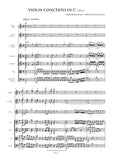Details
|
Joseph Martin Kraus was one of the most gifted and unusual composers of the 18th century, whose talent for thematic development, colourful orchestration and theatrical flair caused Haydn to proclaim him one of only two geniuses he knew (Mozart being the other one). It is known that Kraus played keyboard instruments with a fair degree of proficiency, but his training was first and foremost as a violinist. His Violin Concerto in C is a monumental three-movement work that is similar in format, structure and length to large-scale virtuoso works by Cramer and Viotti. The long first movement features an extended orchestral ritornello of symphonic proportions, during which extensive thematic development occurs. The violin part alters between lyrical episodes and extremely virtuoso passages, characterized by alternations of duple and triple figuration, double stops (mostly thirds), and extreme ranges. The second movement, scored for an accompaniment of strings alone, expands the lyrical passage-work to include extended lines, abrupt shifts of harmony, and more virtuosity. It appears that Kraus, in order to provide a more updated version, rewrote the entire third movement. The change was significant, from a playful 2/4 Scherzo to a lilting 3/8 minuet. Again, the focus is on virtuoso passages, with one particular lyrical line in the upper positions on the G string adding a degree of difficulty seldom found in similar works of the period. The final appoggiatura colophon adds a note of humour, ending the work without the seriousness or solemnity one might expect of so monumental a piece.
|






![Hofmann, Leopold: Cello Concerto in D major (Badley D3) [Study Edition] (AE030/SE)](http://www.artaria.com/cdn/shop/products/AE030_SE_Score_1stpage_1_large.jpg?v=1571438516)


![Hofmann, Leopold: Flute Concerto in D major (Badley D1) [Study Edition] (AE142/SE)](http://www.artaria.com/cdn/shop/products/AE142_SE_Score_1stpage_1_large.jpg?v=1571438516)
![Hofmann, Leopold: Flute Concerto in G major (Badley G2) [Study Edition] (AE145/SE)](http://www.artaria.com/cdn/shop/products/AE145_SE_Score_1stpage_1_large.jpg?v=1571438516)

![Hofmann, Leopold: Flute Concerto in A major (Badley A2) [Study Edition] (AE143/SE)](http://www.artaria.com/cdn/shop/products/AE143_SE_Score_1stpage_1_large.jpg?v=1571438516)
![Hofmann, Leopold: Cello Concerto in D major (Badley D1) [Study Edition] (AE063/SE)](http://www.artaria.com/cdn/shop/products/AE063_SE_Score_1stpage_1_large.jpg?v=1571438516)
